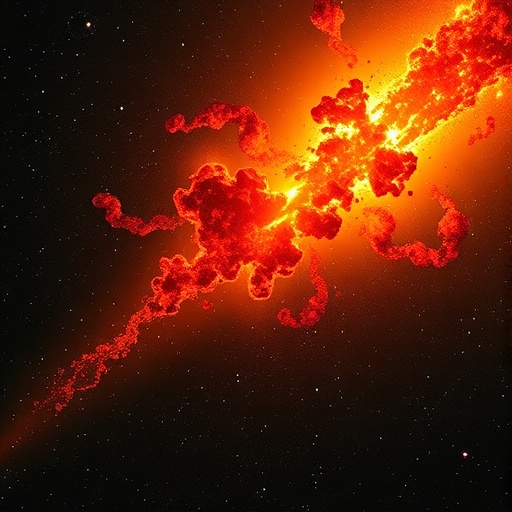In the expansive cosmos, galaxies evolve over billions of years, fueled by complex interactions of dust, gas, and stellar formations. Recent research led by astronomers at the University of Maryland has brought to light the fascinating journey of dust particles ejected from a distant galaxy known as Makani. This galaxy, whose name translates to “wind” in Hawaiian, serves as a crucial case study in understanding the interplay between galactic winds and cosmic dust. By utilizing the advanced capabilities of the James Webb Space Telescope (JWST), researchers have successfully traced these resilient dust particles as they journey through the vast circumgalactic medium (CGM), the ethereal gas enveloping galaxies.
The findings from this study are significant because they represent the first direct observation of infrared emissions from dust at remarkable cosmic distances. This pioneering work, spearheaded by Professor Sylvain Veilleux, elucidates the complex mechanisms by which galactic outflows, driven by intense star formation, contribute to the evolution of galaxies. As stellar winds expel material into the surrounding CGM, the surviving dust may play a pivotal role in planets and star formation, marking a critical phase in the cosmic lifecycle of galaxies.
The research team’s motivation stems from earlier studies in 2019, which established a direct correlation between galactic winds and the formation of the CGM. While those previous findings focused primarily on gas outflows, Veilleux and his colleagues aimed to unravel the fate of dust particles within these dynamic winds. Their investigation revealed that while these microscopic dust grains encountered extreme conditions, including hot gases exceeding 10,000 Kelvin, they appeared to survive the perilous journey in a degraded but intact state.
Veilleux pointed out that the existence of dust in such high-temperature environments posed formidable challenges for survival, as conventional wisdom suggests that materials exposed to gas at such temperatures would vaporize. However, the team hypothesized that the dust might be shielded from the scorching gas by cooler clumps of material, creating protective cocoons during their passage through the CGM. This revelation opens a new frontier in understanding how galactic winds function not merely as destructive forces but as complex systems that can harbor vital ingredients for future celestial bodies.
The research highlights the importance of JWST’s sensitive infrared capabilities, which are indispensable for detecting warm dust that glows brightly, revealing its presence in the cosmos. The inspection of Makani was particularly appealing due to its history of vigorous star formation activity, which produced a significant outflow of gases and dust. The team intends to extend their research by analyzing the spectral fingerprints of dust within the CGM, providing a wealth of new data on particle sizes and characteristics.
Beyond the immediate study of Makani, Veilleux envisions a future where researchers may detect dust on even larger scales, venturing into the intergalactic medium. If successful, this would signify that dust could travel vast distances of more than a million light-years, hinting at a broader cosmic cycle that spans beyond individual galaxies. Such an achievement would fundamentally alter our understanding of cosmic ecology, suggesting that the recycling of materials occurs not just within galaxies but across the vast expanse of the universe.
With each discovery, the narrative of galaxies transforms. They are not mere celestial objects frozen in time but dynamic entities undergoing continuous evolution. Veilleux’s closing thoughts resonate with this theme, suggesting that understanding the processes behind gas and dust cycling is vital for predicting the future trajectories of galaxies. His assertion reflects the desire to not only observe the universe’s history but also to anticipate its future development.
As the JWST continues its mission to unveil the secrets of the universe, the study of the Makani galaxy represents a remarkable milestone in cosmic research. It highlights the interplay of forces and materials that shape galaxies over unimaginable timescales. The journey undertaken by these dust particles exemplifies the cosmic ballet of creation and destruction, evolution and stasis—an intricate saga that continues to unfold.
The continuation of this line of inquiry is crucial for astronomers as they strive to integrate newfound knowledge into a coherent picture of cosmic evolution. The study serves as a testament to the relentless curiosity driving scientists to further our understanding of the universe. It encapsulates the intricate relationships among galaxies, winds, gas, and dust—sowing seeds for future explorations and discoveries.
As researchers prepare for upcoming investigations, the potential implications of these findings extend beyond immediate observational results. They spur conversations on the fundamental processes governing galaxy formation and evolution. By studying these cosmic phenomena, scientists hope to illuminate the intricate web binding together the fabric of the universe.
Veilleux’s efforts, in collaboration with his team, mark a significant leap in the realm of extragalactic astronomy, pushing the boundaries of what we know about the cosmos. The potential to detect dust in the intergalactic medium could herald a new era of research, shedding light on the intricate processes that govern not only our galaxy but that of others, as well. Each revelation fuels the scientific endeavor, bridging theories with observations in the eternal quest to unravel the universe’s mysteries.
In summary, the study of warm dust in the circumgalactic medium is a captivating chapter in the saga of cosmic exploration. It demonstrates the critical role dust plays as a building block for new stars and planets and posits that cosmic recycling processes are pivotal in galaxy evolution. The discoveries made through the use of the JWST open doors to further investigations, potentially reshaping our understanding of dust’s journey across the cosmos. The future lies in exploring the vastness between galaxies, seeking to unveil the hidden stories waiting to be told among the stars.
Subject of Research: Circumgalactic Dust Dynamics
Article Title: JWST Discovery of Warm Dust in the Circumgalactic Medium of the Makani Galaxy
News Publication Date: August 25, 2025
Web References: James Webb Space Telescope
References: The Astrophysical Journal
Image Credits: NASA, University of Maryland
Keywords
Intergalactic Medium, Circumgalactic Medium, James Webb Space Telescope, Galactic Evolution, Cosmic Dust, Astrophysical Journal




